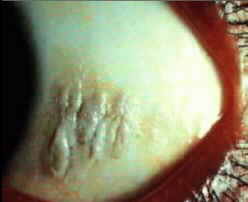
Custom Search
Ancient Egyptians treated Bitot Spots
Bitot spots are an example of an eye manifestation of a systemic disease. They are superficial, irregularly-shaped, foamy gray or white patches that appear on the conjunctiva, the membrane that covers most of the eyeball.
Bitot spots are one of the oldest recorded medical conditions. The ancient Egyptians treated this condition with animal liver more than 3500 years ago. Composed of accumulation of keratinized epithelial debris and secretions, Bitot spots develop into xerophthalmia if not treated. Bitot spots are usually accompanied by night blindness. Eye ulcers develop and the cornea turns to mush (melts) if Bitot spots are not treated. This can result in irreversible blindness.
Bitot spots are most likely due to severe vitamin A deficiency (systemic disease). Bitot spots are also known to occur in people with fat and vitamin malabsorption. Total blindness caused by tissue death due to a severe vitamin A deficiency cannot be treated.
Popular Posts
-
W ind --- pneumonia, atelectasis at 1st 24- 48 hours W ater --- urinary tract infection at Anytime after post op day 3 W ound --- wound ...
-
Raccoon Eyes. Ecchymosis in the periorbital area, resulting from bleeding from a fracture site in the anterior portion of the skull base. Th...
-
Lymph Nodes : The major lymph node groups are located along the anterior and posterior aspects of the neck and on the underside of the jaw. ...
-
Fournier's gangrene is a rare condition and delayed treatment results in fatal outcome. We managed a case of Fournier's gangrene by...
-
Viewed posteriorly the right kidney has its upper edge opposite the 11th dorsal spine and the lower edge of the 11th rib. Its lower edge is ...
-
If you are palpating a swelling like an abdominal swelling infront of the aorta, You have to decide whether the mass you feel is pulsatile/e...
-
This raised skin lesion with a central necrotic area has the appearances of a keratoacanthoma. The natural history of these lesions is that...
-
The sphenoid bone carries its share of creating part of the base of the cranium. While it can be seen laterally and inferiorly, the shape of...











